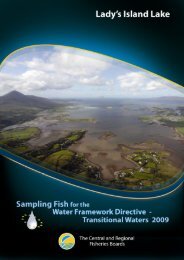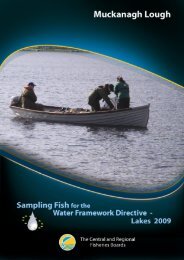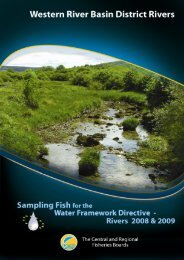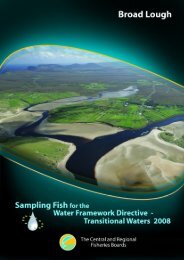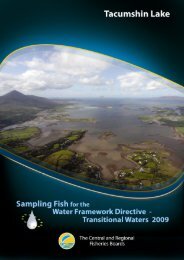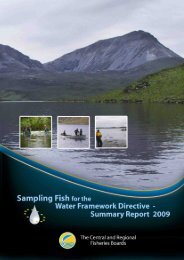HERE - Inland Fisheries Ireland
HERE - Inland Fisheries Ireland
HERE - Inland Fisheries Ireland
- No tags were found...
Create successful ePaper yourself
Turn your PDF publications into a flip-book with our unique Google optimized e-Paper software.
The Central and Regional <strong>Fisheries</strong> BoardsACKNOWLEDGEMENTSThe authors wish to gratefully acknowledge the help and co-operation of the CEO Mr. Vincent Roche,the ACEO Dr. John Conneely and their staff from the North Western Regional <strong>Fisheries</strong> Board. Theauthors would also like to gratefully acknowledge the help and cooperation from all their colleagues inthe Central <strong>Fisheries</strong> Board (CFB).Mr. Roderick Perceval, Templehouse, Co. Sligo provided access to the lake and his help is gratefullyacknowledged.The authors would also like to acknowledge the funding provided for the project from the Departmentof Communications, Energy and Natural Resources for 2008.The report includes Ordnance Survey <strong>Ireland</strong> data reproduced under OSi Copyright Permit No. MP007508.Unauthorised reproduction infringes Ordnance Survey <strong>Ireland</strong> and Government of <strong>Ireland</strong> copyright.© Ordnance Survey <strong>Ireland</strong>, 20092
The Central and Regional <strong>Fisheries</strong> Boards1.2 MethodsThe lake was surveyed over one night on the 6 th of October 2008. A total of three sets of Dutch fykesand 10 benthic monofilament multi-mesh (12 panel, 5-55mm mesh size) survey gill nets (8 @ 0-2.9mand 2 @ 3-5.9m) were deployed randomly in the lake (13 sites). Survey locations were randomlyselected using a grid placed over a map of the lake. A handheld GPS was used to mark the preciselocation of each net. The angle of each gill net in relation to the shoreline was randomised.All fish apart from perch were measured and weighed on site and scales were removed from trout,rudd, roach, pike, bream and hybrids. Live fish were returned to the water whenever possible (i.e.when the likelihood of their survival was considered to be good). Samples of fish were returned to thelaboratory for further analysis.1.3 Results1.3.1 Species RichnessA total of seven fish species and two types of hybrids were recorded on Templehouse Lake in October2008. A list of the species encountered and numbers captured by each gear type is compiled in Table1.1. A total of 276 fish were recorded during the survey. Roach were the most abundant fish speciesencountered in the benthic gill nets. One brown trout was recorded. Eels were also captured duringthe survey.Table 1.1. List of fish species recorded (including numbers captured) during the survey onTemplehouse Lough, October 2008Scientific names Common names Number of fish capturedBenthic monomultimesh gill Dutch fykes TotalnetsSalmo trutta Brown trout 1 0 1Rutilus rutilus Roach 169 1 170Perca fluviatilis Perch 59 1 60Roach x breamhybrids17 0 17Esox lucius Pike 9 0 9Roach x rudd hybrids 9 0 9Scardinius erythrophthalmus Rudd 2 0 2Abramis brama Bream 2 0 2Anguilla anguilla Eel 0 6 64
The Central and Regional <strong>Fisheries</strong> Boards1.3.2 Fish abundanceFish abundance was calculated as the mean number of fish caught per metre of net, i.e. mean CPUE.Fish biomass was calculated as the mean weight of fish caught per metre of net, i.e. mean BPUE. Asummary of CPUE and BPUE data for each species and gear type is shown in Table 1.2.Table 1.2. Mean CPUE (mean number of fish per m of net) and mean BPUE (mean weight offish per m of net) for all fish species recorded on Templehouse Lake, October 2008Gear typeBrowntroutRoach Perch Bream Pike Rudd RuddxRoach RoachxBream EelMean CPUE (mean number of fish/m of net)Gill nets 0.003 0.563 0.197 0.007 0.030 0.007 0.030 0.057 -Fyke nets 0 0.006 0.006 0 0 0 0 0 0.033Mean BPUE (mean weight (g) of fish/m of net)Gill nets 0.090 40.350 9.474 2.710 17.597 2.993 10.912 15.508 -Fyke nets 0 0.111 0 0 0 0 0 0 10.894* In the rare occasion where biomass data was unavailable for an individual fish, this was determined from a length/weight regression forthat species1.3.3 Length frequency distributionsRoach ranged in length from 4.5cm to 31.6cm (mean = 14.7cm) (Fig. 1.2). Perch had recorded lengthsfrom 5.2cm to 29.0cm (mean = 16.0cm) (Fig. 1.3). Roach x bream hybrids ranged in length from15.5cm to 32.5cm. A small number of rudd x roach hybrids were also recorded, with lengths rangingfrom 15.2cm to 33.3cm. Eels ranged in length from 43.2cm to 62.2cm. Nine pike were captured,ranging in length from 38.0cm to 48.8cm.Roach4035BenthicFyke3025No.fish201510501 2 3 4 5 6 7 8 9 10 11 12 13 14 15 16 17 18 19 20 21 22 23 24 25 26 27 28 29 30 31 32Length (cm)Fig. 1.2. Length frequency of roach captured on Templehouse Lake, October 20085
The Central and Regional <strong>Fisheries</strong> Boards10PerchBenthic8No. fish64201 2 3 4 5 6 7 8 9 10 11 12 13 14 15 16 17 18 19 20 21 22 23 24 25 26 27 28 29 30Length (cm)Fig. 1.3. Length frequency of perch captured on Templehouse Lake, October 20081.3.4 Fish age and growthRoach ranged in age from 1+ to 7+. Mean roach L1 was 4.3cm. Perch ranged in age from 0+ to 4+(Table 1.4). Mean perch L1 was 5.6cm. Roach x bream hybrids were aged from 2+ to 9+. Rudd xroach hybrids ranged from 3+ to 10+. The two pike captured were aged 1+ and 2+. Two specimensof rudd (6+ and 8+) were also recorded. The single brown trout captured was aged 1+.Table 1.3. Mean roach growth rates (and SD) for Templehouse Lake, October 2008L 1 L 2 L 3 L 4 L 5 L 6 L 7Mean 4.3 (0.42) 8.4 (1.03) 12.3 (1.26) 16.4 (1.68) 21.5 (1.5) 25.8 (0.94) 28.1 (1.23)N 57 50 39 30 7 4 3Range 3.3-5.2 6.3-10.7 10.4-15.5 14.1-21.2 20.2-24.2 25-27 26.9-29.4Table 1.4. Mean perch growth rates (and SD) for Templehouse Lake, October 2008L 1 L 2 L 3 L 4Mean 5.6 (0.71) 11.5 (1.59) 17.0 (1.88) 19.5 (2.41)N 16 13 11 8Range 4.8-7.3 8.7-14.1 14.5-20.3 16.3-23.36
The Central and Regional <strong>Fisheries</strong> Boards1.4 SummaryRoach was the dominant species in Templehouse Lake, followed by perch and roach x bream hybrids.The mean CPUE for roach in Templehouse Lake was above average when compared with other highalkalinity lakes surveyed during 2008, e.g. Lough Sheelin and Cavetown Lake (Kelly et al., 2009).The CPUE for perch was the lowest for the high alkalinity lakes sampled. The lake also had thehighest CPUE for bream and pike compared to other high alkalinity lakes (Kelly et al., 2009).Roach growth was average in Templehouse Lake when compared to other lakes of high alkalinitysurveyed, e.g. Corglass Lake and Derrybrick Lough. Perch had an average growth rate in comparisonto other high alkalinity lakes, e.g. Lough Egish and Lough Nanoge.Historically bream, rudd and pike were present in the lake. Unfortunately roach (a non-native speciesin <strong>Ireland</strong>) entered the lake post 1980 and have now become the dominant fish species in the lake.Results show that roach have almost completely displaced the rudd population due to hybridizationand competition.Classification and assigning lakes with an ecological status is a critical part of the WFD monitoringprogramme. It allows River Basin District managers to identify and prioritise lakes that currently fallshort of the minimum “Good Ecological Status” that is required by 2015 if <strong>Ireland</strong> is not to incurpenalties. A new WFD multimetric fish classification tool has been developed for the island of <strong>Ireland</strong>(Ecoregion 1) using Agri-Food and Biosciences Institute Northern <strong>Ireland</strong> (AFBINI) and CFB data(Kelly et al., 2008). Using this tool and expert opinion, Templehouse Lake has been assigned a draftclassification of moderate status for fish. The EPA has assigned an overall status of bad toTemplehouse Lake in an interim draft classification. This is based on physico-chemical parametersand biotic elements such as macroinvertebrates and macrophytes.7
The Central and Regional <strong>Fisheries</strong> Boards1.5 ReferencesKelly, F.L., Harrison, A., Connor, L., Allen, M., Rosell, R. and Champ, T. (2008) FISH IN LAKESTask 6.9: Classification tool for Fish in Lakes. FINAL REPORT. Central <strong>Fisheries</strong> Board, NSShare project.Kelly, F.L., Connor, L., Whightman, G., Matson, R. Morrissey, E., O’Callaghan, R., Feeney, R.,Hanna, G. and Rocks, K. (2009) Sampling fish for the Water Framework Directive – Summaryreport 2008. Central and Regional <strong>Fisheries</strong> Boards report.NPWS (2006) http://www.npws.ie/en/media/Media,5028,en.pdf8
The Central and Regional <strong>Fisheries</strong> Boards9



